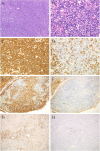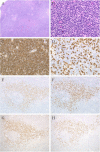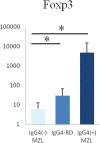A subset of ocular adnexal marginal zone lymphomas may arise in association with IgG4-related disease
- PMID: 26311608
- PMCID: PMC4550912
- DOI: 10.1038/srep13539
A subset of ocular adnexal marginal zone lymphomas may arise in association with IgG4-related disease
Abstract
We previously suggested a relationship between ocular immunoglobulin (Ig)G4-related disease (IgG4-RD) and marginal zone lymphomas (MZLs). However, the cytokine background associated with these disorders and whether it differs between ocular adnexal MZLs with (IgG4-associated MZL) and without (IgG4-negative MZL) numerous IgG4(+) plasma cells are unknown. In this study, we identified the mRNA expression pattern of Th2 and regulatory T-cell (Treg) cytokines in IgG4-RD and in IgG4-associated MZL and IgG4-negative MZL using real-time polymerase chain reaction analysis. Ocular IgG4-RD and IgG4-associated MZL exhibited significantly higher expression ratios of interleukin (IL)-4/β-actin, IL-10/β-actin, IL-13/β-actin, transforming growth factor (TGF) β1/β-actin, and FOXP3/β-actin than did IgG4-negative MZL (p < 0.05). This finding further supports our prior observations that a significant subset of ocular MZLs arises in the setting of IgG4-RD. Furthermore, the presence of a different inflammatory background in IgG4-negative MZLs suggests that IgG4-associated MZLs may have a different pathogenesis.
Figures






Similar articles
-
Upregulated Expression of Activation-Induced Cytidine Deaminase in Ocular Adnexal Marginal Zone Lymphoma with IgG4-Positive Cells.Int J Mol Sci. 2021 Apr 15;22(8):4083. doi: 10.3390/ijms22084083. Int J Mol Sci. 2021. PMID: 33920932 Free PMC article.
-
Clinicopathological Analysis of Ocular Adnexal Extranodal Marginal Zone B-Cell Lymphoma with IgG4-Positive Cells.PLoS One. 2015 Jun 25;10(6):e0131458. doi: 10.1371/journal.pone.0131458. eCollection 2015. PLoS One. 2015. PMID: 26111022 Free PMC article.
-
Ocular adnexal marginal zone B cell lymphoma infiltrated by IgG4-positive plasma cells.J Clin Pathol. 2010 Dec;63(12):1059-65. doi: 10.1136/jcp.2010.082156. Epub 2010 Oct 27. J Clin Pathol. 2010. PMID: 20980530 Free PMC article.
-
Extranodal marginal zone lymphoma from ocular adnexae with subcutaneous involvement.Am J Dermatopathol. 2014 Nov;36(11):e189-93. doi: 10.1097/DAD.0000000000000050. Am J Dermatopathol. 2014. PMID: 25238445 Review.
-
Clinical characteristics and outcomes of IgG4-positive marginal zone lymphoma: Systematic scoping review.Pathol Int. 2022 Jul;72(7):361-370. doi: 10.1111/pin.13251. Epub 2022 Jun 9. Pathol Int. 2022. PMID: 35678201
Cited by
-
The Biology of Ocular Adnexal Marginal Zone Lymphomas.Cancers (Basel). 2022 Feb 28;14(5):1264. doi: 10.3390/cancers14051264. Cancers (Basel). 2022. PMID: 35267569 Free PMC article. Review.
-
Clinical characteristics and treatment outcomes of patients with IgG4-positive ocular adnexal marginal zone B-cell lymphoma.Indian J Ophthalmol. 2024 Nov 1;72(Suppl 5):S902-S906. doi: 10.4103/IJO.IJO_2560_23. Epub 2024 May 20. Indian J Ophthalmol. 2024. PMID: 38767546 Free PMC article.
-
Spectrum of B-cell neoplasms associated with immunoglobulin G4-related disease.Ann Hematol. 2022 Jan;101(1):99-108. doi: 10.1007/s00277-021-04675-w. Epub 2021 Nov 12. Ann Hematol. 2022. PMID: 34767055
-
IgG4-producing lymphoma arising in a patient with IgG4-related disease.Med Mol Morphol. 2016 Dec;49(4):243-249. doi: 10.1007/s00795-016-0139-2. Epub 2016 Apr 11. Med Mol Morphol. 2016. PMID: 27068526
-
Genes and pathways associated with the occurrence of malignancy in benign lymphoepithelial lesions.Mol Med Rep. 2018 Feb;17(2):2177-2186. doi: 10.3892/mmr.2017.8149. Epub 2017 Nov 24. Mol Med Rep. 2018. PMID: 29207199 Free PMC article.
References
-
- Sato Y. et al. Ocular adnexal IgG4-related disease has uniform clinicopathology. Pathol. Int. 58, 465–70 (2008). - PubMed
-
- Sato Y. et al. Ocular adnexal IgG4-producing mucosa-associated lymphoid tissue lymphoma mimicking IgG4-related disease. J. Clin. Exp. Hematop. 52, 51–5 (2012). - PubMed
-
- Sato Y. et al. IgG4-related disease: historical overview and pathology of hematological disorders. Pathol. Int. 60, 247–58 (2010). - PubMed
-
- Masaki Y., Kurose N. & Umehara H. IgG4-related disease: a novel lymphoproliferative disorder discovered and established in Japan in the 21st century. J. Clin. Exp. Hematop. 51, 13–20 (2011). - PubMed
-
- Stone J. H. et al. IgG4-related systemic disease and lymphoplasmacytic aortitis. Arthritis Rheum. 60, 3139–45 (2009). - PubMed
Publication types
MeSH terms
Substances
LinkOut - more resources
Full Text Sources
Other Literature Sources
Medical
Miscellaneous

